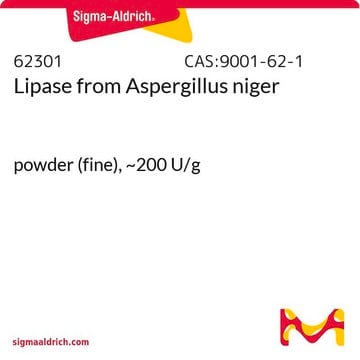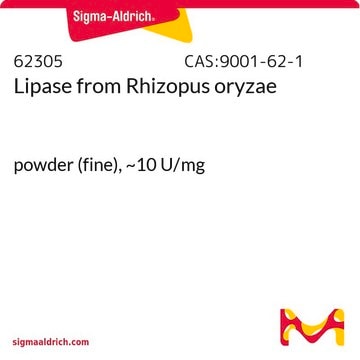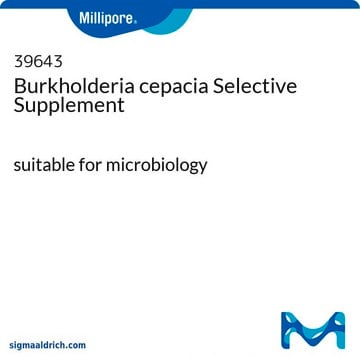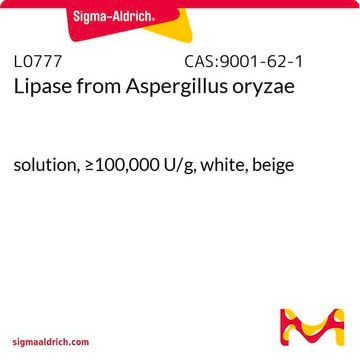62316
Lipase from Candida rugosa
powder, yellow-brown, ≥2 U/mg
Synonim(y):
CCL
About This Item
Polecane produkty
pochodzenie biologiczne
fungus (Candida rugosa)
Poziom jakości
Postać
powder
aktywność właściwa
≥2 U/mg
masa cząsteczkowa
Mr ~67000
warunki przechowywania
dry at room temperature
stężenie
≤100%
metody
analytical sample preparation: suitable
kolor
yellow-brown
zakres pH
6.5—7.5 (0.01 g/L)
rozpuszczalność
water: slightly soluble
Zastosowanie
sample preservation
temp. przechowywania
2-8°C
InChI
1S/C11H9N3O2.Na/c15-8-4-5-9(10(16)7-8)13-14-11-3-1-2-6-12-11;/h1-7,16H,(H,12,14);/q;+1/b13-9-;
Klucz InChI
QWZUIMCIEOCSJF-CHHCPSLASA-N
informacje o genach
fungus ... LAP1(2544)
Szukasz podobnych produktów? Odwiedź Przewodnik dotyczący porównywania produktów
Opis ogólny
The lipase enzyme is a naturally occurring enzyme present in both the stomach and pancreatic juice. It is expressed and active in various tissues. For instance, hepatic lipases are found in the liver, hormone-sensitive lipases in adipocytes, lipoprotein lipase on the vascular endothelial surface, and pancreatic lipase in the small intestine. These lipases are classified within the alpha/beta-hydrolase fold superfamily of enzymes.
Zastosowanie
Działania biochem./fizjol.
Definicja jednostki
Hasło ostrzegawcze
Danger
Zwroty wskazujące rodzaj zagrożenia
Zwroty wskazujące środki ostrożności
Klasyfikacja zagrożeń
Resp. Sens. 1
Kod klasy składowania
11 - Combustible Solids
Klasa zagrożenia wodnego (WGK)
WGK 1
Temperatura zapłonu (°F)
Not applicable
Temperatura zapłonu (°C)
Not applicable
Środki ochrony indywidualnej
Eyeshields, Gloves, type N95 (US)
Certyfikaty analizy (CoA)
Poszukaj Certyfikaty analizy (CoA), wpisując numer partii/serii produktów. Numery serii i partii można znaleźć na etykiecie produktu po słowach „seria” lub „partia”.
Masz już ten produkt?
Dokumenty związane z niedawno zakupionymi produktami zostały zamieszczone w Bibliotece dokumentów.
Klienci oglądali również te produkty
Nasz zespół naukowców ma doświadczenie we wszystkich obszarach badań, w tym w naukach przyrodniczych, materiałoznawstwie, syntezie chemicznej, chromatografii, analityce i wielu innych dziedzinach.
Skontaktuj się z zespołem ds. pomocy technicznej











